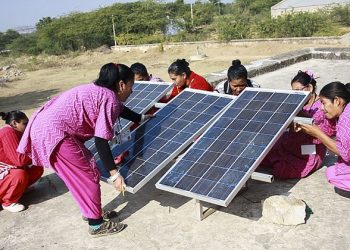The state’s largest utility says it will need energy storage to help it manage a surge of intermittent resources.
by David Thill, Energy News Network
ComEd sees a significant role for energy storage on Illinois’ electric grid as the state works toward realizing its ambitious renewable goals.
“I think you will see that evolution a little bit slower, but it is going to be absolutely a necessary component of the future,” ComEd CEO Joe Dominguez said at a recent City Club of Chicago event.
The utility won’t be the only one with a role to play. As they seek to demonstrate the value of storage, state regulators will consider incentives, and developers will have to continue to make it more affordable and efficient.
Illinois currently has limited storage capacity. A 2018 report from the Smart Electric Power Alliance recorded 0.3 megawatts of storage deployed in the state in 2017. That figure is similar to many states, but some, like California and New York, have launched long-term deployment plans that will significantly increase their storage capacity.
Illinois’ Future Energy Jobs Act focused on building renewable generation through wind and solar. New legislation aims to increase that generation and shift the state toward 100% renewable energy by 2050. With the expansion, especially solar, and the need to store extra energy for use when generation is low, the discussion is turning to storage.
“At the end of the day, if we’re going to handle the intermittency of a lot of renewable resources, storage is going to be a big component of it,” Dominguez said.
ComEd has five storage pilots that are live or in the planning phase, aiming to prove for regulators the technology’s ability to defer costly distribution system upgrades over the long term. The pilots range from a 25-kilowatt community energy storage system in Beecher, Illinois, to a 2-megawatt battery system planned to go live in June in Zion, Illinois.
The company estimates the Zion project will defer expensive upgrades at a substation and feeder for about five years. That could be longer if distributed generation expands in the area and slows load growth. “The energy storage solution at Zion will cost less than half of what it would cost to upgrade the substation using traditional technologies,” according to the company.
But the technology is still expensive. A recent Bloomberg reportetdyerdedaewxdxvvwvrdafdcddxyrarf found the levelized cost of electricity — the cost of producing electricity over the lifespan of a project — for lithium-ion batteries is $187 per megawatt-hour. That’s a steep drop from a year ago, but still higher than solar photovoltaic, at $57 per MWh.
ComEd’s project costs weren’t available, but several experts cited cost as one of the main factors prohibiting large-scale deployment. While prices for storage technology have dropped in recent years, it “still has a way to go to make it economical and affordable,” said Shay Bahramirad, ComEd’s vice president of smart grid and engineering.
Public utilities commissions require utilities to demonstrate the value of their proposed investments. Right now, “the prices are not helping out the evaluation,” said David Chiesa, senior director of global business development at S&C Electric, which initially partnered with ComEd to implement the Beecher pilot. Limited resources have stalled the steady price decrease lately, but that will pick back up as developers find alternatives, he said.
Several experts said they hope the technology evolves beyond lithium-ion batteries to more efficient and environmentally responsible options. Flow batteries, for example, offer a faster charge time and can potentially last longer, both in charge and lifespan.Flywheel storage is another option. These could be useful for utility-scale projects, but lithium-ion remains the most cost-effective option for now.
Policy is another big piece. In addition to long-term deployment plans, several states have incentive programs for storage, and some state commissions have issued guidance for utilities to include storage in their integrated resource plans. Illinois isn’t there yet, but policy experts and researchers said it’s well positioned to get there, as long as decision-makers are proactive.
“It would be very nice for there to be some type of tie-in between energy storage and solar,” Chiesa said. State and federal incentive programs often focus on solar development, but “what would be nice is to see an extension of that to allow solar-plus-storage, because solar-plus-storage is so much more valuable than solar alone.
“Having those two things tied together at the regulatory level would really spur the development of energy storage,” lowering prices and creating a market for the technology, Chiesa said.
The Illinois Commerce Commission held a policy session on storage last June, after which several staff members raised the possibility of a cost-benefit analysis.
While the state has seen minimal policy action on the storage end, “there is a good opportunity for storage in Illinois,” Jason Burwen, vice president of policy at the Energy Storage Association, wrote in emailed comments. For one, he said, the wholesale market offers opportunities for storage, especially as regional transmission organizations like PJM and MISO (both of which cover parts of Illinois) prepare to implement FERC Order 841, in which the Federal Energy Regulatory Commission ruled that storage must be allowed to participate in the markets like generation. It’s already been able to participate to some degree in PJM for several years.
Additionally, Burwen said, “Illinois customers have the same desire for cost savings and resilience that any other state has, and storage will be an important part of integrating higher levels of renewables in state and enhancing Illinois’ distribution system infrastructure.”
“All these technologies will play an important role in the evolution of the 21st-century grid,” Bahramirad said, adding that she predicts storage will be a “key grid asset” in the next five years. “Storage is especially important to realizing the potential of renewable energy.”
This article was first published by the Energy News Network and was reprinted with permission.





